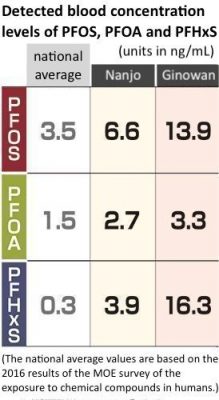Kyoto University professors detect PFOS concentration of 4 times national average in Ginowan residents’ blood

May 17, 2019 Ryukyu Shimpo
By Ryota Shimabukuro
In April Professor Emeritus Akio Koizumi and Associate Professor Koji Harada, medical faculty members of Kyoto University, conducted a study concerning perfluorooctane sulfonate (PFOS), which is suspected to be carcinogenic. Specifically, they examined the concentration of PFOS in the blood of residents of Oyama, Ginowan City, Okinawa. On May 16 the Ryukyu Shimpo found that the study detected PFOS blood concentration levels of four times the national average.
High concentrations of PFOS were detected in rivers in the vicinity of U.S. Kadena Air Base and Futenma Air Station, and the bases have been pointed out as the sources of the contamination. The study also found that there had been negative effects on the subjects’ cholesterol levels and liver functions. Perfluorohexane sulfonic acid (PFHxS), the potential regulation of which is a topic ongoing international discussion, was also detected in the subjects’ blood at more than 53 times the national average.

The use of PFOS and perfluorooctanoic acid (PFOA) is generally prohibited within Japan. Since high concentrations of PFOS and PFOA were detected in the spring water used agriculturally in Oyama, Ginowan City, professors Koizumi and Harada received a request from Oyama residents and conducted examinations on April 13 and 14. They tested the concentrations of PFOS, PFOA, and PFHxS in the blood of 44 residents of Oyama, Ginowan City, and measured the same in the blood of 61 residents of Nanjo City to provide comparison.
Study results showed that in Ginowan City the concentration of PFOS in residents’ blood was four times the national average, at 13.9 nanograms per milliliter (ng/mL). In Ginowan City the results showed PFHxS concentrations at 16.3 ng/mL, more than 53 times the national average. Nanjo PFHxS levels were shown to be 3.9 ng/mL, 12.5 times the national average.
There is a possibility that the manufacture, import, export, and use of PFHxS will be banned by spring 2021. A connection has been drawn between a fire-extinguishing agent used by the U.S. military, and contamination by PFOS, PFOA, and PFHxS.
In Ginowan City, people who drink the tap water on a daily basis have higher concentrations of PFOS, PFOA, and PFHxS in their blood than people who do not drink the tap water. In comparison, in Nanjo City there was not a significant difference in concentration levels between people who drink tap water and those who do not.
The tap water in Ginowan City comes from the Chatan Water Treatment Plant (which supplies seven municipalities), which uses water from a river that passes through Kadena Air Base. Nanjo City’s tap water comes from the Nishihara Water Treatment Plant (which supplies nine municipalities).
Professors Koizumi and Harada pointed out, “It is unclear how [the chemicals] affect health, but judging from the difference from the rest of the country, the source of Ginowan City tap water (the Chatan Water Purification Plant) is contaminated.” They stated, “It is essential that the State shoulder the responsibility of formulating and upholding standards. The source of the contamination may be on base compounds, and it is important for this to be strictly controlled under domestic law.”
(English translation by T&CT and Erin Jones)
Previous Article:Over six times the normal level of hexavalent chromium detected at arena construction site in Okinawa City
Next Article:Editorial: Revised drone law is bad legislation that infringes on the right to information
[Similar Articles]
- Record high concentrations of PFAS detected in groundwater around Kadena Air Base
- OPG finds high PFOS concentrations near Kadena Air Base, advises against drinking the water
- Residents near MCAS Futenma concerned by high concentrations of PFOS/PFOA in water, U.S. military refuses on-base investigation
- JASDF finds 128 times national guideline levels of chemicals like PFOS in water on Naha Base
- High levels of PFOS detected in Kin Town, the highest level at site adjacent to US base
 Webcam(Kokusai Street)
Webcam(Kokusai Street)


